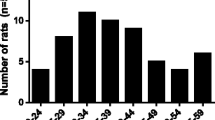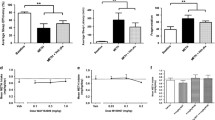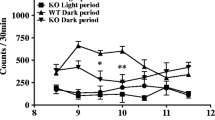Abstract
The recreational drug “Ecstasy” [3,4-methylenedioxymethamphetamine (MDMA)] has a well-characterised neurotoxic effect on the 5-hydroxytryptamine (5-HT) neurons in animals. Despite intensive studies, the long-term functional consequencies of the 5-HT neurodegeneration remains elusive. The aim of this study was to investigate whether any alteration of 5-hydroxytryptamine-3 (5-HT3) receptor functions on the sleep–wake cycle, motor activity, and quantitative EEG could be detected 6 months after a single dose of 15 mg/kg of MDMA. The selective 5-HT3 receptor agonist m-chlorophenylbiguanide (mCPBG; 1 mg/kg, i.p.) or vehicle was administered to freely moving rats pre-treated with MDMA (15 mg/kg, i.p.) or vehicle 6 months earlier. Polysomnographic and motor activity recordings were performed. Active wake (AW), passive wake (PW), light slow wave sleep (SWS-1), deep slow wave sleep (SWS-2), and paradoxical sleep were classified. In addition, EEG power spectra were calculated for the second hour after mCPBG treatment for each stage. AW increased and SWS-1 decreased in the second hour after mCPBG treatment in control animals. mCPBG caused significant changes in the EEG power in states with cortical activation (AW, PW, paradoxical sleep). In addition, mCPBG had a biphasic effect on hippocampal theta power in AW with a decrease in 7 Hz and a stage-selective increase in the upper range (8–9 Hz). Effects of mCPBG on the time spent in AW and SWS-1 were eliminated or reduced in MDMA-treated animals. In addition, mCPBG did not increase the upper theta power of AW in rats pre-treated with MDMA. These data suggest long-term changes in 5-HT3 receptor function after MDMA.


Similar content being viewed by others
References
Adori C, Ando RD, Kovacs GG, Bagdy G (2006) Damage of serotonergic axons and immunolocalization of Hsp27, Hsp72, and Hsp90 molecular chaperones after a single dose of MDMA administration in Dark Agouti rat: temporal, spatial, and cellular patterns. J Comp Neurol 497(2):251–269
Ando RD, Benko A, Ferrington L, Kirilly E, Kelly PA, Bagdy G (2006) Partial lesion of the serotonergic system by a single dose of MDMA results in behavioural disinhibition and enhances acute MDMA-induced social behaviour on the social interaction test. Neuropharmacology 50(7):884–896
Ando RD, Adori C, Kirilly E, Molnar E, Kovacs GG, Ferrington L, Kelly PA, Bagdy G (2009) Acute SSRI-induced anxiogenic and brain metabolic effects are attenuated 6 months after initial MDMA-induced depletion. Behav Brain Res (in press)
Balogh B, Molnar E, Jakus R, Quate L, Olverman HJ, Kelly PA, Kantor S, Bagdy G (2004) Effects of a single dose of 3, 4-methylenedioxymethamphetamine on circadian patterns, motor activity and sleep in drug-naive rats and rats previously exposed to MDMA. Psychopharmacology (Berl) 173(3–4):296–309
Barnes JM, Barnes NM, Costall B, Deakin JF, Ironside JW, Kilpatrick GJ, Naylor RJ, Rudd JA, Simpson MD, Slater P et al (1990) Identification and distribution of 5-HT3 recognition sites within the human brainstem. Neurosci Lett 111(1–2):80–86
Belforte JE, Pazo JH (2004) Turning behaviour induced by stimulation of the 5-HT receptors in the subthalamic nucleus. Eur J Neurosci 19(2):346–355
Bufton KE, Steward LJ, Barber PC, Barnes NM (1993) Distribution and characterization of the [3H]granisetron-labelled 5-HT3 receptor in the human forebrain. Neuropharmacology 32(12):1325–1331
Capela JP, Carmo H, Remiao F, Bastos ML, Meisel A, Carvalho F (2009) Molecular and cellular mechanisms of ecstasy-induced neurotoxicity: an overview. Mol Neurobiol 39(3):210–271
Colado MI, Williams JL, Green AR (1995) The hyperthermic and neurotoxic effects of ‘Ecstasy’ (MDMA) and 3, 4 methylenedioxyamphetamine (MDA) in the Dark Agouti (DA) rat, a model of the CYP2D6 poor metabolizer phenotype. Br J Pharmacol 115(7):1281–1289
Costall B, Domeney AM, Naylor RJ, Tyers MB (1987) Effects of the 5-HT3 receptor antagonist, GR38032F, on raised dopaminergic activity in the mesolimbic system of the rat and marmoset brain. Br J Pharmacol 92(4):881–894
Engleman EA, Rodd ZA, Bell RL, Murphy JM (2008) The role of 5-HT3 receptors in drug abuse and as a target for pharmacotherapy. CNS Neurol Disord Drug Targets 7(5):454–467
Fitzgerald JL, Reid JJ (1990) Effects of methylenedioxymethamphetamine on the release of monoamines from rat brain slices. Eur J Pharmacol 191(2):217–220
Gerbrandt LK, Lawrence JC, Eckardt MJ, Lloyd RL (1978) Origin of the neocortically monitored theta rhythm in the curarized rat. Electroencephalogr Clin Neurophysiol 45(4):454–467
Graff C, Challet E, Pevet P, Wollnik F (2007) 5-HT3 receptor-mediated photic-like responses of the circadian clock in the rat. Neuropharmacology 52(2):662–671
Green AR, Mechan AO, Elliott JM, O’Shea E, Colado MI (2003) The pharmacology and clinical pharmacology of 3, 4-methylenedioxymethamphetamine (MDMA, “ecstasy”). Pharmacol Rev 55(3):463–508
Gyongyosi N, Balogh B, Kirilly E, Kitka T, Kantor S, Bagdy G (2008) MDMA treatment 6 months earlier attenuates the effects of CP-94, 253, a 5-HT1B receptor agonist, on motor control but not sleep inhibition. Brain Res 1231:34–46
Hagan RM, Kilpatrick GJ, Tyers MB (1993) Interactions between 5-HT3 receptors and cerebral dopamine function: implications for the treatment of schizophrenia and psychoactive substance abuse. Psychopharmacology (Berl) 112(1 Suppl):S68–S75
Herges S, Taylor DA (2000) Involvement of 5-HT(3) receptors in the nucleus accumbens in the potentiation of cocaine-induced behaviours in the rat. Br J Pharmacol 131(7):1294–1302
Higgins GA, Joharchi N, Sellers EM (1993) Behavioral effects of the 5-hydroxytryptamine3 receptor agonists 1-phenylbiguanide and m-chlorophenylbiguanide in rats. J Pharmacol Exp Ther 264(3):1440–1449
Holsheimer J, Feenstra BW (1977) Volume conduction and EEG measurements within the brain: a quantitative approach to the influence of electrical spread on the linear relationship of activity measured at different locations. Electroencephalogr Clin Neurophysiol 43(1):52–58
Kankaanpaa A, Lillsunde P, Ruotsalainen M, Ahtee L, Seppala T (1996) 5-HT3 receptor antagonist MDL 72222 dose-dependently attenuates cocaine- and amphetamine-induced elevations of extracellular dopamine in the nucleus accumbens and the dorsal striatum. Pharmacol Toxicol 78(5):317–321
Kantor S, Jakus R, Molnar E, Gyongyosi N, Toth A, Detari L, Bagdy G (2005) Despite similar anxiolytic potential, the 5-hydroxytryptamine 2C receptor antagonist SB-242084 [6-chloro-5-methyl-1-[2-(2-methylpyrid-3-yloxy)-pyrid-5-yl carbamoyl] indoline] and chlordiazepoxide produced differential effects on electroencephalogram power spectra. J Pharmacol Exp Ther 315(2):921–930
Karageorgiou J, Dietrich MS, Charboneau EJ, Woodward ND, Blackford JU, Salomon RM, Cowan RL (2009) Prior MDMA (Ecstasy) use is associated with increased basal ganglia-thalamocortical circuit activation during motor task performance in humans: an fMRI study. Neuroimage 46(3):817–826
Karlsen SN, Spigset O, Slordal L (2008) The dark side of ecstasy: neuropsychiatric symptoms after exposure to 3,4-methylenedioxymethamphetamine. Basic Clin Pharmacol Toxicol 102(1):15–24
Kilpatrick GJ, Jones BJ, Tyers MB (1988) The distribution of specific binding of the 5-HT3 receptor ligand [3H]GR65630 in rat brain using quantitative autoradiography. Neurosci Lett 94(1–2):156–160
Kilpatrick GJ, Jones BJ, Tyers MB (1989) Binding of the 5-HT3 ligand, [3H]GR65630, to rat area postrema, vagus nerve and the brains of several species. Eur J Pharmacol 159(2):157–164
Kirilly E, Molnar E, Balogh B, Kantor S, Hansson SR, Palkovits M, Bagdy G (2008) Decrease in REM latency and changes in sleep quality parallel serotonergic damage and recovery after MDMA: a longitudinal study over 180 days. Int J Neuropsychopharmacol 11(6):795–809
Mazzola-Pomietto P, Aulakh CS, Murphy DL (1995) Temperature, food intake, and locomotor activity effects of a 5-HT3 receptor agonist and two 5-HT3 receptor antagonists in rats. Psychopharmacology (Berl) 121(4):488–493
McCann UD, Ricaurte GA (2007) Effects of (±) 3, 4-methylenedioxymethamphetamine (MDMA) on sleep and circadian rhythms. ScientificWorldJournal 7:231–238
McGregor IS, Clemens KJ, Van der Plasse G, Li KM, Hunt GE, Chen F, Lawrence AJ (2003) Increased anxiety 3 months after brief exposure to MDMA (“Ecstasy”) in rats: association with altered 5-HT transporter and receptor density. Neuropsychopharmacology 28(8):1472–1484
Mylecharane EJ (1996) Ventral tegmental area 5-HT receptors: mesolimbic dopamine release and behavioural studies. Behav Brain Res 73(1–2):1–5
O’Shea E, Granados R, Esteban B, Colado MI, Green AR (1998) The relationship between the degree of neurodegeneration of rat brain 5-HT nerve terminals and the dose and frequency of administration of MDMA (‘ecstasy’). Neuropharmacology 37(7):919–926
Papp M (1988) Similar effects of diazepam and the 5-HT3 receptor antagonist ICS 205–930 on place aversion conditioning. Eur J Pharmacol 151(2):321–324
Parrott AC (2005) Chronic tolerance to recreational MDMA (3, 4-methylenedioxymethamphetamine) or Ecstasy. J Psychopharmacol 19(1):71–83
Perry DC (1990) Autoradiography of [3H]quipazine in rodent brain. Eur J Pharmacol 187(1):75–85
Ponzoni A, Monti JM, Jantos H (1993) The effects of selective activation of the 5-HT3 receptor with m-chlorophenylbiguanide on sleep and wakefulness in the rat. Eur J Pharmacol 249(3):259–264
Porras G, De Deurwaerdere P, Moison D, Spampinato U (2003) Conditional involvement of striatal serotonin3 receptors in the control of in vivo dopamine outflow in the rat striatum. Eur J Neurosci 17(4):771–781
Pratt GD, Bowery NG, Kilpatrick GJ, Leslie RA, Barnes NM, Naylor RJ, Jones BJ, Nelson DR, Palacids JM, Slater P et al (1990) Consensus meeting agrees distribution of 5-HT3 receptors in mammalian hindbrain. Trends Pharmacol Sci 11(4):135–137
Rajachandran L, Spear NE, Spear LP (1993) Effects of the combined administration of the 5-HT3 antagonist MDL 72222 and ethanol on conditioning in the periadolescent and adult rat. Pharmacol Biochem Behav 46(3):535–542
Reznic J, Staubli U (1997) Effects of 5-HT3 receptor antagonism on hippocampal cellular activity in the freely moving rat. J Neurophysiol 77(1):517–521
Rothman RB, Baumann MH, Dersch CM, Romero DV, Rice KC, Carroll FI, Partilla JS (2001) Amphetamine-type central nervous system stimulants release norepinephrine more potently than they release dopamine and serotonin. Synapse 39(1):32–41
Sainsbury RS (1998) Hippocampal theta: a sensory-inhibition theory of function. Neurosci Biobehav Rev 22(2):237–241
Schierenbeck T, Riemann D, Berger M, Hornyak M (2008) Effect of illicit recreational drugs upon sleep: cocaine, ecstasy and marijuana. Sleep Med Rev 12(5):381–389
Schmidt CJ (1987) Neurotoxicity of the psychedelic amphetamine, methylenedioxymethamphetamine. J Pharmacol Exp Ther 240(1):1–7
Semenova TP, Tiku MK (1997) Interactions between the serotoninergic and noradrenergic systems of the brain and their role in the regulation of animal behavior. Neurosci Behav Physiol 27(3):280–282
Shankar RP, Karan RS, Handu SS, Bhargava VK (2000) Effect of the 5-HT3 receptor antagonist ondansetron on amphetamine-induced hyperactivity and stereotypy in rats. Indian J Physiol Pharmacol 44(3):355–358
Shankaran M, Gudelsky GA (1998) Effect of 3, 4-methylenedioxymethamphetamine (MDMA) on hippocampal dopamine and serotonin. Pharmacol Biochem Behav 61(4):361–366
Staner L, Graff C, Luthrhinger R, Noel N (2008) Effect of the selective activation of serotonin 5-HT3 receptors on sleep and waking. In: Monti JM, Pandi-Perumal SR, Jacobs BL, Nutt DJ (eds) Serotonin and sleep: molecular, functional and clinical aspects. Birkhauser, Switzerland
Staubli U, Xu FB (1995) Effects of 5-HT3 receptor antagonism on hippocampal theta rhythm, memory, and LTP induction in the freely moving rat. J Neurosci 15(3 Pt 2):2445–2452
Stefanski R, Palejko W, Bidzinski A, Kostowski W, Plaznik A (1993) Serotonergic innervation of the hippocampus and nucleus accumbens septi and the anxiolytic-like action of the 5-HT3 receptor antagonists. Neuropharmacology 32(10):987–993
Stone DM, Merchant KM, Hanson GR, Gibb JW (1987) Immediate and long-term effects of 3, 4-methylenedioxymethamphetamine on serotonin pathways in brain of rat. Neuropharmacology 26(12):1677–1683
Waeber C, Pinkus LM, Palacios JM (1990) The (S)-isomer of [3H]zacopride labels 5-HT3 receptors with high affinity in rat brain. Eur J Pharmacol 181(3):283–287
Yamamoto BK, Spanos LJ (1988) The acute effects of methylenedioxymethamphetamine on dopamine release in the awake-behaving rat. Eur J Pharmacol 148(2):195–203
Acknowledgments
This study was supported by the Sixth Framework Programme of the E.C., LSHM-CT-2004-503474, the Hungarian Research Fund Grant T020500 and M27976, the Ministry of Health Research Grant 460/2006, the Fund Management of Ministry of Education OMFB 01926/2002, PhD Fellowship Program of the Semmelweis University, Ministry of Education, Hungary, and the Hungarian National Scientific Research Fund (OTKA, K 68960).
Author information
Authors and Affiliations
Corresponding author
Rights and permissions
About this article
Cite this article
Gyongyosi, N., Balogh, B., Katai, Z. et al. Activation of 5-HT3 receptors leads to altered responses 6 months after MDMA treatment. J Neural Transm 117, 285–292 (2010). https://doi.org/10.1007/s00702-009-0357-z
Received:
Accepted:
Published:
Issue Date:
DOI: https://doi.org/10.1007/s00702-009-0357-z




